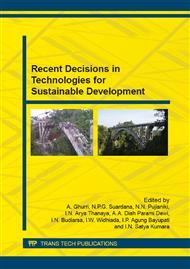p.59
p.66
p.74
p.80
p.87
p.95
p.101
p.108
p.114
Port Location Selection Model: Case Study of Tourism Sector in Bali
Abstract:
We employ an integrated model to decide the location of the most optimum harbor infrastructure of tourism in determining the tourism attractiveness for destinations. This study identifies the factors that influence the tourists’ choice for destination and evaluates the tourists’ preference for destinations. A 4-level AHP model, consisting of 22 attributes on the 4th level, developed by Tzu-Kuang Hsu, was proposed and tested using data collected from tourists who visited Bali to establish the relative importance of pre-selected factors (criteria). By using fuzzy set theory and TOPSIS, the preference of 47 given destinations corresponding to each criterion can be evaluated and their final rankings can also be defined. Based on the results of this preference, ten alternative port locations were evaluated using Traveling Salesman Problem (TSP) models to find the travel package tours with a minimum duration that can be visited with a long period of time. The TSP model implemented in this study is expected to be able to integrate tourist destinations and transportation systems. The results of computation using the TSP model revealed that Benoa Harbor is the best place to dock for cruise ships based on the number and rank of the tourist preference for destinations that can be visited.
Info:
Periodical:
Pages:
87-94
Citation:
Online since:
July 2015
Keywords:
Price:
Сopyright:
© 2015 Trans Tech Publications Ltd. All Rights Reserved
Share:
Citation:


